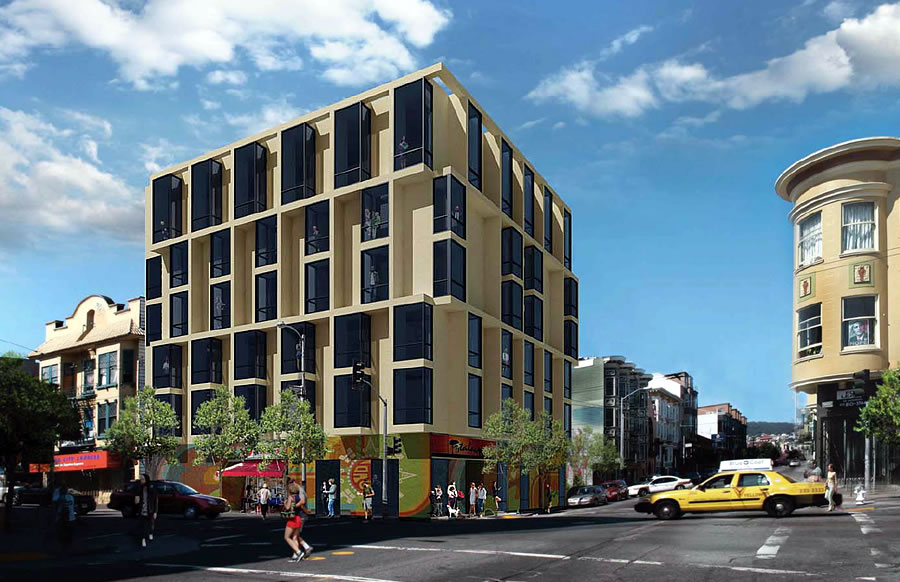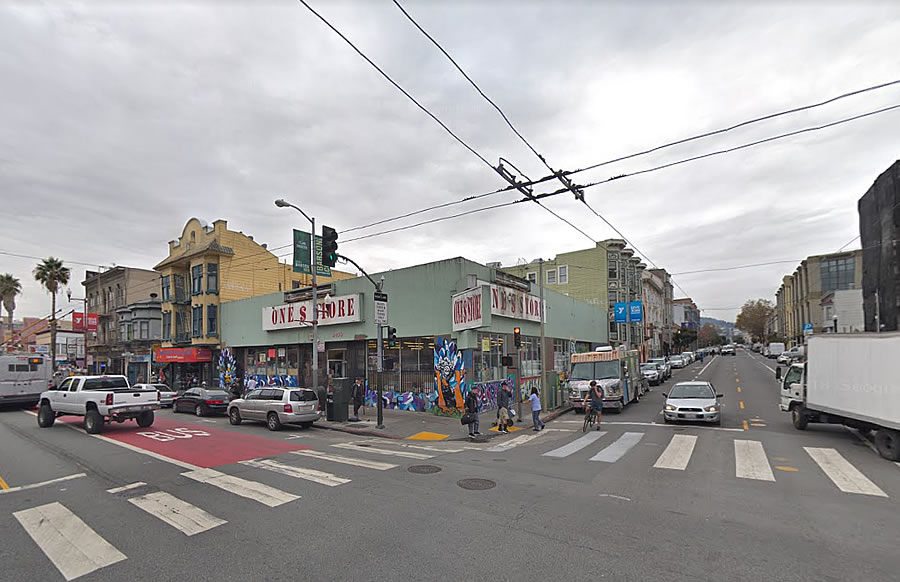Having already been redesigned to look “less upscale” and eliminate its garage, the proposed redevelopment of the “One $ Store” parcel on the southwest corner of Mission and 17th Streets was subsequently challenged by the Mission Economic Development Agency (MEDA) for the potential loss of a “low-price-point community-serving retail” establishment and the number of condos within the development to be offered at below market rates.
In response, the project team asked the operator of the One $ Store to consider returning to the future retail space, with a below market (but above current) rent, but the operator declined. Goodwill, however, has been approached by the project team and is currently “expected” to sign a lease for the future space.
At the same time, while the total number of condos to rise above the retail space has been reduced from twenty-nine (29) to twenty-seven (27), the code compliant number of units to be offered at below market rates (12 percent) remains at three (3).
And with all that in mind, San Francisco’s Planning Department is recommending that the Planning Commission reject MEDA’s formal challenge of the project and approve the development of 2100 Mission Street as proposed next week.


The notched entry in the old Saitowitz proposal was nice, but heaven forbid we have nice things here. Instead we get stucco and some ground floor mural that will get tagged. Oh well, we get what we deserve! At least 27 condos will come of it once it’s all said and done.
I like the previous design better, even though it looked out of place. This is really ugly. Uglier than most of the crap that’s being built these days, in this city. But who are we? And maybe this is what we deserve. It would be better for the community if it were all BMR. But maybe then it wouldn’t get built at all. Maybe that’s not a bad thing.
Amen. Community-driven design does not make things attractive. That beige is SO bad, like 1986 bad.
I disliked the original design but this is truly horrible. OTOH, apparently the goal was to make it look crappier (i.e. less upscale), so kudos to them on their success.
I, for one, have always wanted to live in a medical office building.
LOL nailed it!
Yep. Design in SF’s Mission District is turning into a celebration of mediocrity. It seems like the goal is to disappoint all the factions equally.
Why do we live in a city in which there is a constituency vigorously arguing–and winning–that a building is not ugly enough? Isn’t that incredibly condescending to the low-income residents of the neighborhood? In New York City, they build gorgeous high rises with high numbers of low-income units that have gyms, pools, climbing walls, etc. Nobody ever says “there are going to be poor people here so we can’t have that nice stuff.” (Of course, they have “poor door” controversies there, which are horrible, but still a marked improvement from this insanity).
Too many people here making a living “serving the poor” and they need to justify their keep. Same groups are tunnel visioned, lacking business and common sense.
If NYC used the SF style of doing things, it would remain a small village.
SF is a dysfunctional city on a host of fronts. Either that or it’s something in the water. It’s not just the banal/mediocre architecture, It’s the filthy streets, un-kept parks and public spaces and rampant car break-ins. The NYT article on SF asked how is it that one of the wealthiest cities in America can have such dirty and unsafe streets. The answer is that too many are on the take in SF – including more than a few city employees. And too many are just passing through on their travels to a better job and better quality of life. Neither group gives a dam* about SF. And it shows.
If you’re right, doesn’t it make you question why there is such a great demand for housing here? Place down the street accepted an above asking offer after its first showing last weekend.
Housing has both a consumption (living in it) and an investment (making money off it) purpose. During an up-cycle the investment aspect grows in importance as people pile into the market hoping to reap rich gains off home price appreciation. This reduces the relative importance of the consumption aspect. And for a very large cycle, this effect is very large.
Do you care about the quality of the engraving on the stock certificate of a hot stock? All these quality/blandness issues that people point out about recently created housing are mystifying if you believe that people have suddenly gotten richer and thus should be acquiring ever more luxurious homes. But completely consistent with a surge in investment interest due to the large up-slope of a housing cycle.
Even among rentals and not just in SF, the vacancy rate for the top 10% of units has doubled since 2013.
Do you care if a homeless person is defecating on your doorstep if you’re not there to step in it?
I’m sorry you’re so miserable, but this is a great city, admired the World over, and I’m very happy to have made it my home.
Do you ever get out of downtown? I’ve lived here for 24 years, and have seen enormous improvements in parks, playgrounds, libraries in neighborhoods around the city.
In the ’90’s Mission Bay was a wasteland of run down warehouses and a driving range – now it’s a burgeoning medical, residential, and commercial area. The TL and SOMA were terrible then, and are still terrible but have actually shrunk in the past 20 years.
I’d argue that the city is in part a victim of it’s own success – the increasing visibility of the underbelly (needles, feces, ranters, etc.) is due in large part to the fact that the City has developed many of the interstitial spaces that hid those activities in the past. So now they are more concentrated, and exacerbated by the high price of housing that constricts the number of flophouses, SROs, and other places that kept the marginally housed off the streets.
I don’t know about “on the take”, but your comment about “passing through” feels right on. Some of the social ills you list (like car breakins) are a symptom of the same syndrome – abundance of high-value soft targets, and perpetrated by people who feel no connection to the larger city community if they even live here at all.
One of the main – if often overlooked – differences b/w SF and NYC is that in the later the urban (19thC “city”) areas are all under the same political umbrella; this gives both flexibility and accountability in how it deals with metro-wide issues: all too often SF has been happy to shift problems onto it’s neighbors – Feinstein, that self-serving ***** was particularly notorious for this, once imploring people to dispose of their guns in Oakland so SF would be safer (and of course this is seen in the frequent comments on SS deriding Oakland). In NYC, that can’t happen, since a murder in Bed-Stuy gets charged to the same political regime that serves Murray Hill…even if the physical distance is just as far. And (partly) as a result, SF has become remarkably inefficient at dealing with even mundane issues…despite having money that would make Solomon envious.
“Inefficient” – you think!! Excuses don’t cut it. Many cities are smallish like SF and seem to be able to maintain control and maintenance of things. Many cities are much smaller and do the same. The change in the road and landscape maintenance going from SF to DC via Lake Merced is fairly pronounced (though not as great as the transformation on I5 from California to Oregon) and is telling. You gotta love the city employees that “maintain” the Lake Merced area. Let’s see – they start rolling out at 2 or 2:30 on work days. No full day of work needed. It’s a great gig if you can get it.
Dear WTF, while NYC does build affordable housing, there are no city-wide affordable housing requirements. Currently, NYC encourages developers to include affordable housing in their projects when a project seeks rezoning, or by offering tax incentives, but there are no city-wide affordability mandates. Whereas San Francisco requires an affordability component when a developer builds a project with 10 or more units city-wide.
Also, I agree that NYC builds some inspiring buildings, but the majority of NYC’s construction is uglier than San Francisco’s housing. Yes, certain NYC neighborhoods get great buildings such as along the High Line or parts of mid-town and downtown. But the majority of housing that’s built is terribly uninspiring if not downright ugly. NYC’s marquis buildings are exceptional but the most NYC buildings are as mundane as all else.
That point I’m trying to make is that it’s not an apples to apples comparison between NYC and SF. There are tradeoffs in either direction.
Bosh, Hancock. You are contradicting the Doom, Despair, and Agony on Me theme of this post. Of course San Francisco is the worst city in the universe! Of course all public employees are lazy. I expect Dave to pop in here waxing poetic about the comparative joys of Fresno and Redding.
As for Oakland-bashing, that is primarily because of the somewhat hysterical Oakland is The Center Of The Universe musings of certain regulars.
What’s wrong with making it look modern and upscale. If the builders are meeting affordable requirements, why do we want to make harder for them to build. If you don’t build, it’s going to push More people out.
UPDATE: Approved Dollar Store Development on the Market in the Mission